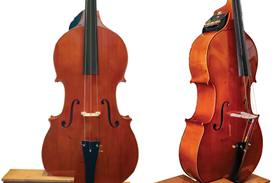A second volume of quartets impresses with its drama

The Strad Issue: October 2024
Description: A second volume of quartets impresses with its drama
Musicians: Calidore Quartet
Works: Beethoven: String Quartets: op.59 nos.1–3 ‘Rasumovsky’; op.74 ‘Harp’; op.95 ‘Serioso’
Catalogue number: SIGNUM SIGCD872 (3 CDs)
The Calidore Quartet is working backwards through Beethoven. Having already recorded the late quartets, it has now reached the middle five. In the opening movement of the F major op.59 no.1 the players set out their stylistic stall with bright, pure-toned playing and strong contrasts: delicacy builds to a satisfyingly robust fortissimo. Later the strange, hushed, questioning minim chords are interrupted by a startlingly fierce forte attack. In the second movement crisp semiquavers, neatly played in isolation by instruments passing the phrases between them, lead into fierce homorhythmic urgency. Here again contrasts are dynamic and vivid. The Adagio is full of controlled eloquent intensity. The Russian theme of the third movement is upbeat, and what follows is mostly robust, with plenty of rhythmic vitality.
The first movement of op.59 no.2 is mellifluous and assertive, attentive to Beethoven’s many hairpins and accents. In the Molto adagio, leader Jeffrey Myers brings great expression to his repeated decorative figure over the opening chorale. The musicians proceed with gentle grace, contemplative and smooth, which makes the occasional forte outbursts all the more striking. The Allegretto is light and airy, and the Thème russe trips along genially until it launches into strong, vibrant colour. The finale is a sparkling dance, full of incidental detail.
Read: ‘The cycle demands relentless focus’ - the Calidore Quartet on performing Beethoven’s string quartets
Read: Session Report: The Calidore Quartet on recording Beethoven’s late quartets
The quartet’s penchant for vehement contrast is apparent again in the Andante introduction to the C major Quartet op.59 no.3, with strident attacks on the forte chords and caressing delicacy on the pianissimos. The Allegro vivace that follows is all warmth and joie de vivre. The second movement has a congenial flow. In the third the opening of the Trio breaks in on the easy progress of the Menuetto with an almost military attack. The finale flies along, the quavers slightly separated and the tone always focused.
The generally sunny first movement of the ‘Harp’ Quartet op.74 has compelling drama in the development, and Myers dashes off his semiquaver passage in the coda in fine style. The long-breathed expressive lyricism of the Adagio leads into heartfelt tragedy as it moves into A flat minor. The pristine playing of the Presto gives it an almost Mendelssohnian quality despite its C minor intensity, and the various characters of the last movement variations are well caught.
In the F minor Quartet op.95 severity is mixed with beguiling beauty. The slow movement has mystery, not least in the quiet chromatic uncoiling of the fugal section. In the Allegro assai there is gripping nervous energy and an unsettling sense of anxiety which goes on to pervade the finale. The recorded sound is close and clear.
TIM HOMFRAY









































No comments yet